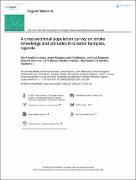| dc.contributor.author | Kaddumukasa, Mark | |
| dc.contributor.author | Kayima, James | |
| dc.contributor.author | Nakibuuka, Jane | |
| dc.contributor.author | Mugenyi, Levi | |
| dc.contributor.author | Ddumba, Edward | |
| dc.contributor.author | Blixen, Carol | |
| dc.contributor.author | Welter, Elisabeth | |
| dc.contributor.author | Katabira, Elly | |
| dc.contributor.author | Sajatovic, Martha | |
| dc.date.accessioned | 2021-04-30T10:02:34Z | |
| dc.date.available | 2021-04-30T10:02:34Z | |
| dc.date.issued | 2017-05-19 | |
| dc.identifier.citation | Kaddumukasa, M., Kayima, J., Nakibuuka, J., Mugenyi, L., Ddumba, E., Blixen, C., Welter, E., Katabira, E. and Sajatovic, M., 2017. A cross-sectional population survey on stroke knowledge and attitudes in Greater Kampala, Uganda. Cogent medicine, 4(1), p.1327129. | en_US |
| dc.identifier.issn | 2331-205X | |
| dc.identifier.uri | http://hdl.handle.net/20.500.12280/2809 | |
| dc.description.abstract | Background: Stroke is a neurological condition with rapidly increasing burden in many low- and middle income countries. Africa is particularly hard-hit due to rapid population growth, patterns of industrialization, adoption of harmful western diets, and increased prevalence of risk factors such as hypertension and obesity. Reducing stroke risk factors and teaching people to respond to stroke warning signs can prevent stroke and reduce burden. However, being able to address gaps in knowledge and improving both preventative and early-response care requires a clear understanding of practical and potentially modifiable topics. In this cross sectional study, we assessed the knowledge and attitudes among an urban population residing within the greater Kampala, Uganda.
Methods: A population cross sectional survey was conducted in urban Mukono, district, central Uganda. Through the systematic sampling method, data were gathered from 440 adult participants who were interviewed about selected aspects of stroke knowledge, attitudes and perception using a pretested structured questionnaire. Results: A total of 440 study participants were enrolled. The leading risk factors for stroke identified by the participants were stress (75.7%) and hypertension (45.2%) respectively. Only two (0.5%) of the study participants identified cigarette smoking as a stroke risk factor. Individuals with hypertension have poor knowledge regarding stroke in spite their high risk for stroke. Conclusion: Stroke knowledge is poor while, stress and hypertension are the leading perceived risk factors in our settings. While stress is contributing factor, hypertension is likely a more amenable and practical intervention target. Targeting individuals with stroke risk factors to increase stroke knowledge and education is crucial for engagement in healthcare. Implementing a self-management program to support and motivate this high-risk group as well as adopting healthy life-styles may be a way to reduce stroke burden in Uganda. | en_US |
| dc.language.iso | en | en_US |
| dc.publisher | Informa UK Limited | en_US |
| dc.relation.ispartofseries | Cogent medicine;4(1) | |
| dc.subject | Stroke | en_US |
| dc.subject | Hypertension | en_US |
| dc.subject | Global health | en_US |
| dc.subject | Knowledge | en_US |
| dc.subject | Risk factors | en_US |
| dc.subject | Warning factors | en_US |
| dc.title | A Cross-Sectional Population Survey on Stroke Knowledge and Attitudes in Greater Kampala, Uganda | en_US |
| dc.type | Article | en_US |


